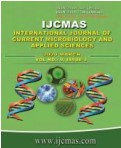


 National Academy of Agricultural Sciences (NAAS)
National Academy of Agricultural Sciences (NAAS)

|
PRINT ISSN : 2319-7692
Online ISSN : 2319-7706 Issues : 12 per year Publisher : Excellent Publishers Email : editorijcmas@gmail.com / submit@ijcmas.com Editor-in-chief: Dr.M.Prakash Index Copernicus ICV 2018: 95.39 NAAS RATING 2020: 5.38 |
Huanglongbing (HLB) or Citrus Greening Disease is a widespread and serious threat to the Citrus growing industry worldwide due to its complexity and destructiveness. On an average, the disease can cause 30 to 100 per cent yield loss around the globe depending on its severity. In Assam, an important factor associated with Citrus decline is the wide spread prevalence of Huanglongbing (HLB) in Khasi mandarin (Citrus reticulata). HLB was detected by molecular methods in Khasi mandarin orchards of Assam state in North-eastern India. Total DNA was extracted from the mid rib of the collected symptomatic as well as asymptomatic leaf samples using Cetyl trimethylammonium bromide (CTAB). The yield and purity of the extracted DNA samples were then estimated by measuring in a Nano drop and absorbance ratio was recorded at 260 nm and 280 nm (A260/A280) followed by PCR amplification using HLB primer pair A2 and J5 for amplification from the specific DNA fragments. PCR results revealed that the above mentioned primer pair yielded a ~703 base pair at an annealing temperature of 56oC which was resolved in gel electrophoresis and were further sequenced. Sequence analysis of the PCR products confirmed the presence of Candidatus Liberibacter asiaticus with 95-99 per cent similarities with other known isolates. The quantitative analysis of HLB was also done by Real Time PCR using SYBR Green and Actin gene as control. The amplification curves in qPCR for duplicated assays were overlapping and had a mean Ct value of 29.42 for the healthy sample while Ct values for the infected leaf samples from location viz., Tinsukia, Dibrugarh, Jorhat and Golaghat were 21.74, 21.63, 22.5 and 22.9 respectively.
 |
 |
 |
 |
 |